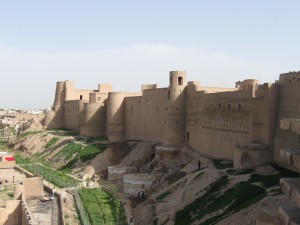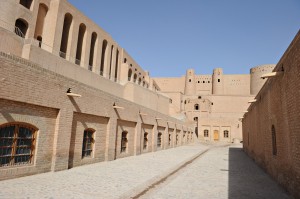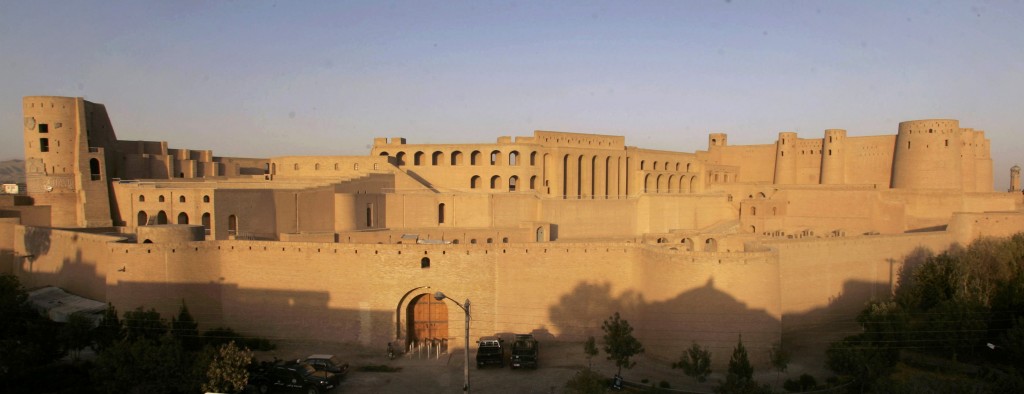 After decades of war and neglect, the medieval citadel of Qala Ikhtyaruddin in Herat, western Afghanistan, has been restored. Funded by a donation from the Aga Khan Trust for Culture and support from the U.S. and German governments, Afghan craftsmen have been working since 2008 to make extensive repairs to the masonry and structure of the walls and ramparts which were in such bad shape they were visibly crumbling. Buildings within the citadel’s lower enclosure were also repaired or replaced with period-appropriate replicas.
After decades of war and neglect, the medieval citadel of Qala Ikhtyaruddin in Herat, western Afghanistan, has been restored. Funded by a donation from the Aga Khan Trust for Culture and support from the U.S. and German governments, Afghan craftsmen have been working since 2008 to make extensive repairs to the masonry and structure of the walls and ramparts which were in such bad shape they were visibly crumbling. Buildings within the citadel’s lower enclosure were also repaired or replaced with period-appropriate replicas.
The citadel has been destroyed or come close to it many times in its checkered history. In 1950 plans to demolish the citadel were thankfully derailed, and UNESCO oversaw extensive conservation of the site between 1976 and 1979. Unregulated development in Herat’s city center, battles and the presence of a military garrison put unbearable pressure on the citadel and its ancient materials, many of which was reused for new construction. The enormous size and complexity of the site makes conservation a major logistical challenge. It is more than 250 meters (800 feet) long and 70 meters (230 feet) wide in places. Its two main enclosures contained deteriorating buildings, courtyards and 18 brick masonry towers.
 Herat was an important crossroads on the Silk Road, the trade route that moved luxury goods between the Levant and India and China. Excavations have discovered evidence of habitation on the site dating back to the sixth century B.C. Alexander the Great himself occupied the area in 330 B.C. and is thought to have built the first fortress on the site. Not the last, though, as Herat’s prime location made it attractive to every occupation force in the area. The citadel was destroyed by the Mongolian army 1221, rebuilt by the Persian Kartid dynasty, then destroyed again by Timur’s (Tamerlane’s) army in 1380. It was Timur’s son, Shah Rukh, and his wife Queen Gowhar Shād who implement extensive construction programs in the 15th century, creating the walled citadel of brick, stone and glazed tiles that we see today.
Herat was an important crossroads on the Silk Road, the trade route that moved luxury goods between the Levant and India and China. Excavations have discovered evidence of habitation on the site dating back to the sixth century B.C. Alexander the Great himself occupied the area in 330 B.C. and is thought to have built the first fortress on the site. Not the last, though, as Herat’s prime location made it attractive to every occupation force in the area. The citadel was destroyed by the Mongolian army 1221, rebuilt by the Persian Kartid dynasty, then destroyed again by Timur’s (Tamerlane’s) army in 1380. It was Timur’s son, Shah Rukh, and his wife Queen Gowhar Shād who implement extensive construction programs in the 15th century, creating the walled citadel of brick, stone and glazed tiles that we see today.
It’s not just the crumbling masonry that’s been repaired. The project focused also on adapting ancient buildings to modern uses while preserving their historical architecture. Several buildings have been converted into a public cultural center that has been used to much acclaim for concerts and art shows. There is also a provincial archeological museum.
Housed at the citadel is the National Museum of Herat, one of four provincial museums in Afghanistan to reopen to the public. The Museum of Islamic Art in Berlin worked with the German Archaeological Institute to document and restore artifacts and prepare them for display. There are about 1,100 items from the Herat region in the museum; about 250 are on display.
Most of them are from the 10th to 13th centuries when Herat was a center of politics and culture. There is pottery, metal work, a tombstone of major Persian painter Behzad, 260 manuscripts and books and a cenotaph adorned with tiles that date from 1378.
Tourism seems like a distant prospect, what with the war and all, but preserving Afghanistan’s immense cultural heritage is the first step in making it possible at all.
